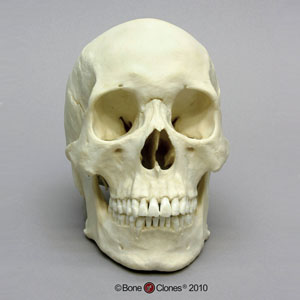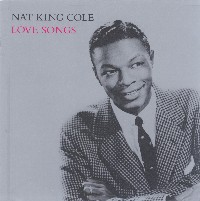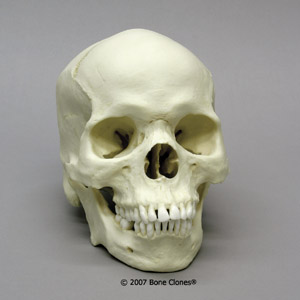 My clinic partner in chiropractic school was part Japanese and part Hawaiian. He had a huge round head. I used to tease him and say it was so big and round you could bowl with it. His eyes, which were mere slits, would get even smaller as he broke out in a grin. I would look him square in the eyes and say how do you see out of those things and the remaining slits would turn to dashes as his grin stretched and strained his cheeks to the max.
My clinic partner in chiropractic school was part Japanese and part Hawaiian. He had a huge round head. I used to tease him and say it was so big and round you could bowl with it. His eyes, which were mere slits, would get even smaller as he broke out in a grin. I would look him square in the eyes and say how do you see out of those things and the remaining slits would turn to dashes as his grin stretched and strained his cheeks to the max.
The roundness of the head and eye sockets is evident in the well cast skull seen above. Permission to use the pictures of the skull in this post was granted by Bone Clones Inc. The aperture of the nose is also rounder compared to the more triangular shape of European skull design.
The head is the sound box of the human voice. The tonal quality of the voice is affected by the design of the head, especially the mouth, nose and air sinuses, called the paranasal sinuses.
The bridge of the nose, called the glabella, sits above the opening. Behind the bridge are the ethmoid sinuses. The large maxillary sinuses lie beneath the cheek bones to the sides of the nose. The frontal sinuses are in the forehead just above the nose. The sphenoid sinus sits behind and between the eyes. Singing resonates in the sinuses and escapes through the nose. Yoga kundalini exercise uses the AUM chant to resonate the sphenoid sinus and stimulate the pituitary gland which sits above the sphenoid sinus. The difference in shape of the nasal opening affects the escape of air like the difference in shape between f holes in violins and jazz guitars and round holes in country guitars.
 In this regard, the design of the African-American skull is a perfect shape for singing. One of the finest quality voices ever recorded was that of Nat King Cole. Rich and mellow the music would escape his head with near perfect unobstructed flow.
In this regard, the design of the African-American skull is a perfect shape for singing. One of the finest quality voices ever recorded was that of Nat King Cole. Rich and mellow the music would escape his head with near perfect unobstructed flow.
 If you strip away the flesh it’s easy to see that the roundness of an African-American skull is closer in design to Asian skulls. The head is not box-like as in European designs, but smoother and rounder. The eye sockets are also rounder. The nasal aperture is especially round.
If you strip away the flesh it’s easy to see that the roundness of an African-American skull is closer in design to Asian skulls. The head is not box-like as in European designs, but smoother and rounder. The eye sockets are also rounder. The nasal aperture is especially round.
The difference in the round designs versus square European designs may explain why Asians and African-Americans have a much lower incidence of MS. On the other hand, it may explain why they get a particularly devastating variant form of MS called Devic’s disease.
The floor of the base of Asian and African skulls is longer than European skulls. The back wall of the head in Asians is taller but slightly more sloped than African designs which are steeper. The longer base and steep rear wall distribute more of the weight of the brain behind the foramen. On the other hand, it positions the brainstem over the foramen magnum prediposing it to sinking into a Chiari malformation.
Chiari malformations were once considered to be a herniation of the brainstem into the foramen magnum thus compressing it. More recent research suggests that the definition should be changed to include any decrease in CSF volume which causes the brain to sink and come in contact with the bones of the cranial vault. Recent research has also linked Chiari malformations with trauma, MS and chronic fatigue syndrome among other things.
Devic’s disease is associated with neuromyelitis optica and transverse myelitis but typically has no MS-like lesions in the brain. While transverse myelitis is associated with hyperintensity signals in the cord, the lesions differ from MS in that they are longer and tend to span several segments of the spine. Devics disease can result in blindness and muscle weakness in the arms and legs. It can also cause respiratory failure.
The optic nerve sits beneath the weight of the frontal lobes of the brain. It is protected from compression by cerebrospinal fluid (CSF) in the interchiasmatic cistern, which is the highest cistern in the brain. In round skull designs Chiari malformations most likely result in contact of the frontal lobe of the brain against the vault thus compressing the optic nerve. Herniation of the brainstem into the foramen magnum further compresses the long nerve tracts from the brain that go to the cord resulting in muscle weakness and respiratory stress.
Let’s consider a hypothetical example of a European, Asian and African-American traveling together in a car that gets into a traumatic motor vehicle accident. Soon afterwards they all develop problems with loss of vision and weakness in the legs. Brain scans show white spots in the brain of the European and in the cord of the Asian and African-American. In this case the European person is diagnosed with MS and the Asian and African-American with Devic’s disease. In all three cases, it will be blamed on an immunolgical problem, when in fact it is simply a different response to the same traumatic cause.
For more information on this and related topics visit my website at http://www.upright-health.com

Dr. Flanagan,
Another excellent post — encouraging us to think outside the box (or ball!). Your points are excellent. I never fully believed that sun exposure was the only factor in regional variations in the incidence of M.S. Racial differences in our skulls are huge, and when thinking about Chiari, even a mm is significant.
In your book, when you describe poor CSF drainage filling the cisterns and putting pressure on the brainstem (and thus imitating symptoms and signs of Chiari), I think you are onto something HUGE. I know so many people disabled by signs and symptoms of Chiari and anterior brainstem damage, but whose imaging shows basically nothing.
Please keep in mind one of my particular favorites – Ehlers-Danlos Syndrome (EDS) with autonomic dysfunction. With EDS, of course, we see mid-face hypoplasia and narrow, high palates, downward slanting eyes and there is some evidence to suggest that the eustachian tubes may be abnormally short, or slanted. EDS and M.S. overlap a great degree. I’ll be interested in your thoughts as to these abnormal skull formations in patients who are usually, not just Caucasian — but “pasty white” Caucasians!
Thank you, Dr. Flanagan for your thoughts and your dedication.
My brother-in-law was diagnosed last week with Devic’s Disease…3 months after being hit in the head so hard with a baseball, it knocked him down. The treatment approach assumes an autoimmune issue. Any guidance about further testing, treatments, specialists would be enormously appreciated!
Hello Charolotte,
It’s my opinion that Lou Gehrigh most likely got ALS from getting hit in the temple area of the head with a fast ball that knocked him out. A baseball swing develops a great deal of force. In contrast to the temple area, your brother in law was probably struck in the back or rear quarter of the head, which is more in line with the layout of the optic nerve. Regardless of where he was hit, it caused the brain to accelerate rapidly in the vault crash against bones and other parts. Internal tissues of the cranial vault such as the optic nerve can get strained, especially in the optic canal. Skull design affects the layout of the brain and how tissues and fluids react to rapid acceleration-deceleration. Additionally, the force from the strike most likely whiplashed the craniocervical junction in the upper cervical spine, which can further result in torn connective tissues and misalignment strains. Your brother-in-law needs a good orthopedic and neurological evaluation, including x-rays of his cervical spine.
I very much appreciate your quick and interesting reply! After I wrote you, I learned that my brother-in-law also got hit in the back of the head with a baseball at age 14, lost consciousness and suffered a concussion. I suppose the more recent hit further traumatized this vulnerable area. Can you give me some idea about what initial treatment might need to be for this kind of older injury? How does he find a qualified chiropractor who embraces your research? Does an autoimmune disorder also correlate with an injury like this..or could an autoimmune component be coincidence? Or is the Devic’s Disease diagnosis merely a misunderstanding of the root problem?
Thanks,
Charlotte
Your welcome Charlotte. Although many disagree, my theory is that Devic’s diseases and optic spinal multiple sclerosis are;variants of MS caused by craniocervical trauma such as whiplash. The difference in lesion location has to do with differences in the interior design of the cranial vault. The problem with Devic’s and optic spinal MS is that they tend to be more aggressive and debilitating. Your brother-in-law has history of significant trauma most likely associated with inflammation not immunological problems. If he has immunological problems I would expect to see signs such as in blood differentials and chemistry signs, skin conditions, allergies, rheumatism, arthritis, diabetes etc. The optic nerve is highly vulnerable to trauma in the optic canal. The upper cervical spine and cord are likewise very susceptible to head and neck injuries. It would be interesing to know where the lesions are as well as to check for possible cerebellar tonislar ectopia (aquired Chiari malformation). I am very interested in Devic’s. I am not trying to promote my self but if you purchase a copy of my book it includes a complimentary cursory consultation with my contact information  so we can discuss his condition further as well as where he lives. The book is a story about my research written for lay people. The story format makes the complex topics easier to digest.
http://www.upright-health.com/Upright-Doctor-book.html
Warm regards,
Dr. Flanagan
Thanks so very much. My brother-in-law plans to purchase your book! Your information has been incredibly helpful.
Your welcome. He should contact me as soon as he gets the book.